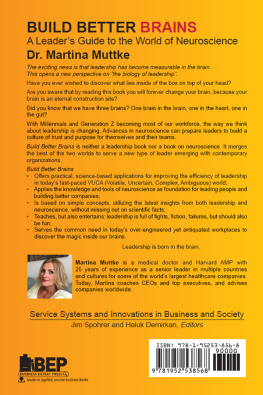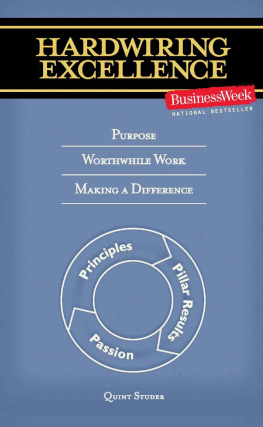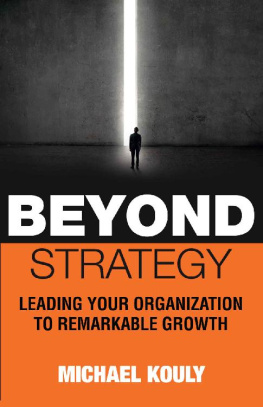Table of Contents
To Karen Warner, who teaches leaders how to lead
FOREWORD
By Marshall Goldsmith
Major changes have occurred in the world of organizations since the late 1990s. In fact, not since the Industrial Revolution have we seen such rapid and significant change in the world of organizations. These changes, brought on by such forces as globalization, the development of technology, and their impact on our societies, are becoming increasingly evident as we progress into the 21st century.
As the century unfolds, new realities are becoming clearer. Multinational mega-organizations are emerging, and organizations are consolidating through mergers and acquisitions, yet simultaneously, smaller and mid-sized companies do flourish. New models of leadership are blossoming, some with unfounded success. For instance, focusing on working better as teams and empowering those closest to the customers to make important decisions have led to great accomplishments.
But who is to say what model will work for any specific organization, industry, or team? Because of the diversity of customers, technologies, and areas of operation, companies cant produce just workbooks and manuals anymore. The world is too big, too changing, and too varied. As a result, leaders and their followers must make the right decisions on their own because they have internalized the organizations mission, values, strategy, and brand.
Companies that understand this hire leaders who pay as much attention to developing the culture of the organization as to the individuals who make up the organization. They hire leaders who focus on common purposebuilding a sense of inclusiveness within the organization where people know what to do and why, and understand what the organization stands forand stand with it!
In Common Purpose: How Great Leaders Get Organizations to Achieve the Extraordinary, Joel Kurtzman takes his many years of research, personal observation, interviews, and interactions with leaders and distills them into one critical concept that is the essence of good leadership: excellent leaders create a feeling of we among the members of their group, team, or organizationthey do this in order that the organization, now aligned around a common set of goals, is nearly undefeatable by any circumstance or competitor.
The road to common purpose in leaders and leadership is not an easy one. This book provides a road map to stay on that journeyand to succeed along the way.
Life is good.
Marshall Goldsmith is the best-selling author of What Got You Here Wont Get You There, Succession: Are You Ready?, and MOJO.
INTRODUCTION: NO ONE LEADS ALONE
Since the end of World War II, tens of thousands of books, articles, studies, and theories have been developed on the topic of leadership, with thousands more coming out each year. People are fascinated by the subject and want to discover how they can become better leaders or rise to leadership-level positions. Authors and researchers have approached the topic from a wide variety of perspectivesbusiness, politics, religion, communityand from disciplines like psychology, economics, and sociology. Theyve studied primate behavior, whale and dolphin pods, people in prison, native tribes living in the worlds rain forests and savannas, CEOs, politicians, and sports figures.
And yet despite all this work, a consensus has so far failed to emerge with respect to what leadership is, how leaders develop, andperhaps most importanthow to become a more effective leader. Ideas about how to rise inside organizations run the gamut from, Its all luck and politics, to Its all hard work and preparation, to Youve got to generate your own internal PR, to Theres no limit to how high you can climb as long as you dont care who gets the credit. Others point to the power of teams and team building and of finding the right team to join. And still others say you have to select a few choice assignments for yourself and then shine. As a result, the appetite for ideas that provide answers to the puzzle of leadership is almost insatiable.
This book, which is the result of years of research and hundreds of interviews and personal observations and interactions with leaders, provides an answer to the leadership question. But in my opinion it is different from all those leadership books and studies already on the shelf because it demonstrates that the heart and soul of leadership is the creation of common purpose. Common purpose is a new concept.
What is common purpose? To me, it is that rare, almost palpable experience that happens when a leader coalesces a group, team, or community into a creative, dynamic, brave, and nearly invincible we. It happens the moment the organizations values, tools, objectives, and hopes are internalized in a way that enables people to work tirelessly toward a goal. Common purpose is based on a simple idea: the leader is not separate from the group he or she leads. Rather, the leader is the organizations gluethe force that binds it together, sets its direction, and makes certain that the group functions as one. Common purpose is rarely achieved, but I have seen it when a leader is able to bring about results that are outsized, measurable, and inspiring.
My interest in this topic was kindled long before I became editor-in-chief of the Harvard Business Review, where one in seven articles submitted to the magazine, out of more than four thousand articles submitted each year, was about leadership. My interest was provoked long ago by Warren Bennis when I was an editor, reporter, and columnist at The New York Times.
Bennis, a professor of business at the University of Southern California and a long-time student of leadership, had written many books on the topic. As a journalist, I did most of The New York Timess CEO interviews and also interviewed a great many politicians and military leaders. Because of those interviews, I became fascinated with how certain people were able to motivate the troops (literally and figuratively) day in and day out.
One day when Bennis was in New York, I asked him how leaders inspire and encourage followers (for lack of a better word) to take action. How did someone like Dwight D. Eisenhower, for example, motivate 160,000 soldiers to cross the English Channel and storm Normandys beaches underneath a constant hail of lead? Or, more mundanely, how does Sam Palmisano, chairman and CEO of IBM, ensure that the companys 388,000 employees are working together, and not just for themselves? How do leaders make certain the individuals in their organizations are contributing value to the bottom line? What enables leaders to keep their people aligned? And what prevents chaos from breaking out? In short, how does a leader transform individuals from me into we? And why do some leaders fail?
The answer Bennis gave was clever. Leaders dont do it alone, he said. Good leaders are not outsiders who cheer on a group. They are part of that group, integrated deeply into its fabric and emotional life. Great generals may climb the ranks, he said, but they are still soldiers. Someone who views himself as an outsider or as above the other members of the group can almost never succeed as a leader.
So there must be a sense of identity and connection between leaders and led? I asked.
Yes, Bennis replied. If there isnt a deep connection, a real fit, the leader will fail. Quite literally, he continued, when there isnt a fit, the group will either eject the leader or destroy itself in the attempt.









